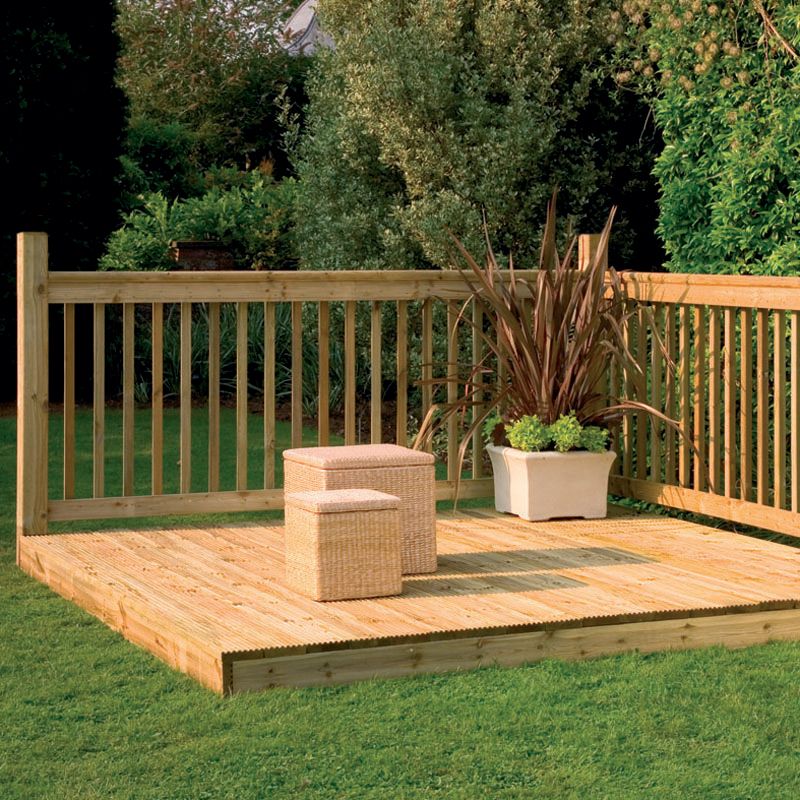Can I build decking beside my neighbours fence?
There are a couple of rules to be aware of…


Spending as much time outside as possible is likely to be at the top of everyone's list in the UK this summer, as we attempt to make the most of the few sunny days we’re usually granted.
But if you’ve grown tired of your grass or patio, you may currently be considering adding some decking to your outside space. Garden decking can be a great option if you’re looking to enjoy a cornered off section of your space raised up from the grass. And not only is it fairly easy to build, but lots of decking material is also super durable, and should be able to withstand any weather damage as well as potential animal or insect damage – making it a fantastic, low-maintenance choice.
There are lots of things to know about adding decking to your garden (and how to lay decking). But if you have nearby neighbours, one of the first things you might be considering is whether or you can build decking right up against your neighbours’ fence – and if so, how close said decking can be to their fence, particularly if you share a fence on either or both sides.
To help you plan your deck so that it’s adheres with all relevant regulations, here’s what the experts have to say about whether or not you can build decking beside your neighbours’ fence.
Can I build decking beside my neighbours’ fence?

Technically, yes – building decking beside your neighbours' fence is legal and allowed. In fact, many people who have installed decking will build this right beside a neighbours fence. However, there are some stipulations and restrictions you should be aware of, all of which are there to ensure the privacy and comfort of all parties involved.
Darren Gooch, TrexPro Platinum Installer and director of Beams and Braces explains that he would actually advise against building right up to your neighbours' fence in order to avoid any problems arising down the line.
'I would always advise independently installing your deck, rather than attaching to a fence boundary line or neighbouring property,' he says.
Sign up to our newsletter for style inspiration, real homes, project and garden advice and shopping know-how
Why is keeping a distance a good idea, even if it isn't legally required? 'Keeping off the boundary line and not cutting your deck into the posts means that if your neighbour was to change the fencing, it wouldn’t cause problems to the installation,' says Darren.
Many experts also argue that not building your decking right beside your neighbours fence is simply polite, too – and will allow them as much privacy as possible as they go about their lives in their own space.
How much space you should leave between your decking and the neighbour's fence

Murray Michel, garden maintenance and decking expert at Clear Amber shares that it's worth considering the impact of installing decking right up to your neighbours' fence.
'Although no national regulation dictates a minimum distance between decking and a boundary fence, homeowners must consider the potential impact on their neighbor’s property, including privacy, light and garden enjoyment,' he says.
Considering a minimum distance between your decking and your neighbours' fence is therefore likely to be a wise idea, in order to respect your neighbours privacy (and your own), Murray tells us.
'Maintain a reasonable gap between the decking and the fence – ideally at least 20-30cm (8-12 inches). This distance accounts for future maintenance of the fence and helps avoid potential disputes,' he says.
Do you need planning permission for a decking area?

Most deckings don’t require planning permission, even, as explained, if you want to build it right beside your neighbours' fence. But Murray states that your decking will need to stay under a certain height and width to avoid requiring planning permission, and in order to maintain the privacy of both parties involved; yourself, and your neighbour.
'Building decking beside a neighbour's fence is common, but it is essential to follow specific regulations to ensure legality,' he says. 'There is a critical 30cm height rule that stipulates that decking exceeding 30cm (approximately 12 inches) in height above ground level generally requires planning permission.
'This regulation is designed to prevent significant overlooking and to preserve the privacy of adjacent properties.'
Greg Parkins, Business Development Manager at Deck Supermarket also points out that your decking (or any raised platform), should also not cover too much of your garden, to avoid needing planning permission. 'Decking does not require planning permission if, together with extensions, garden rooms, and other outbuildings, it does not cover more than 50% of the garden.'
So if you can ensure that your decking doesn’t exceed 30cm (or 12 inches) in height and doesn’t span more than 50% of your garden, you shouldn't need planning permission for the area – but conversely, if it goes above these regulations, you will.

Greg also explains that if you are building a decking (especially one closer to your neighbours' fence) you may also want to think about its style and design, to avoid any further potential issues with permissions. In fact, not thinking about this issue in within a conservation area can be one of the biggest decking mistakes people make.
'Decks that visually clash with their surroundings might face stricter scrutiny,' he explains. 'For example, decks that clash with the natural or architectural context of their environment may go against regulations where there’s stringent guidelines to protect the scenic quality and ecological balance of areas.
'By choosing appropriate materials, colours, and designs, and by consulting with planning authorities, you can create a deck that enhances rather than disrupts its surroundings,' Greg says.
Where to buy decking

For a contemporary look, try composite decking in this geometric tile format. The grey will help surrounding flowers and soft accessories pop.

Amy Hunt is an experienced digital journalist and editor, now working in a freelance capacity specialising in homes and interiors, wellness, travel and careers. She was previously Lifestyle Editor at woman&home, overseeing the homes, books and features sections of the website. Having worked in the industry for over eight years, she has contributed to a range of publications including Ideal Home, Livingetc, T3,Goodto, Woman, Woman’s Own, and Red magazine.

